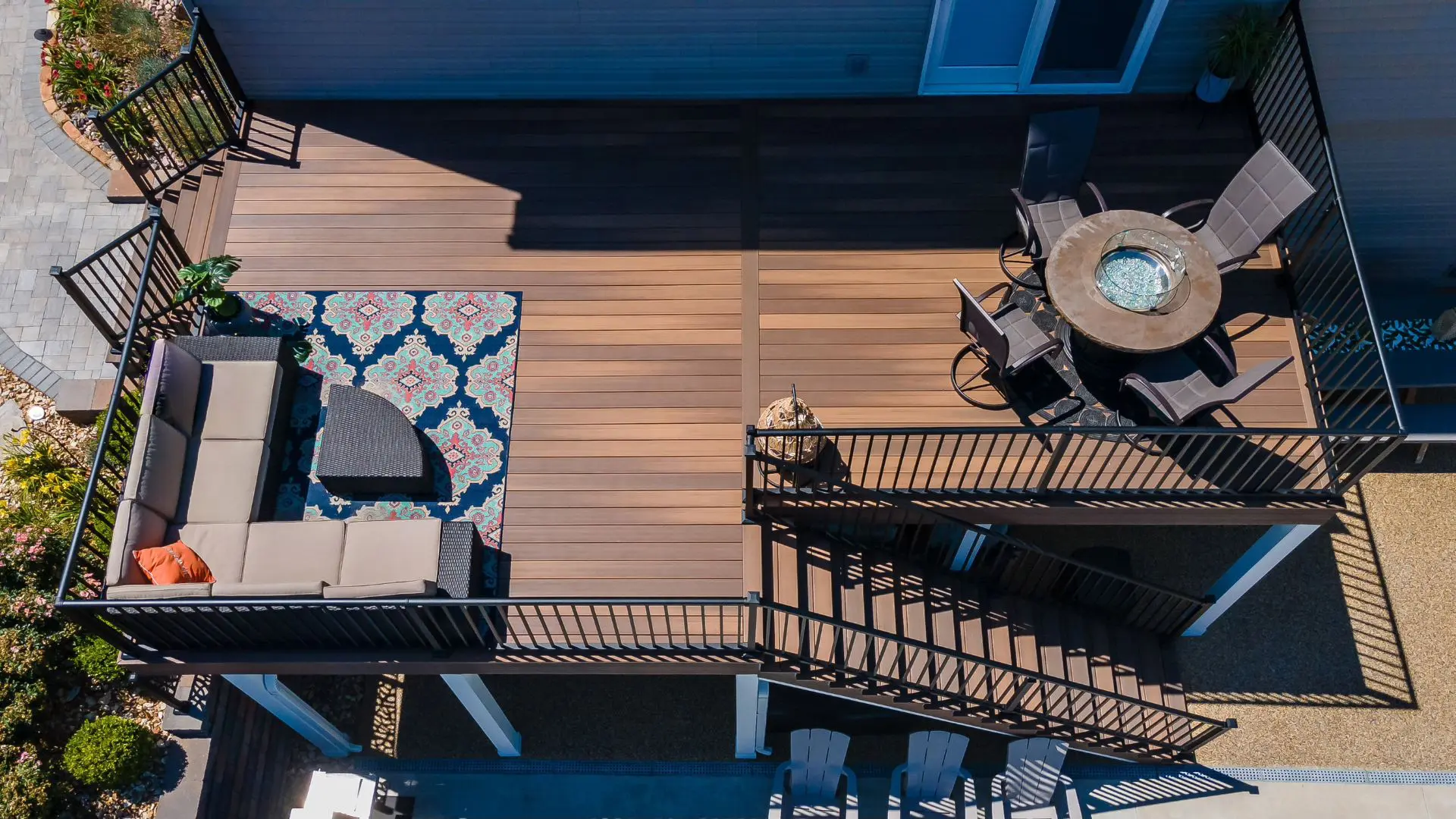Deck Safe Grills: A Comprehensive Guide to Outdoor Cooking Safety
Introduction
The aroma of sizzling steaks and the warmth of a grill on a summer evening are quintessential pleasures of outdoor living. However, the combination of high-heat cooking equipment and wooden structures presents unique challenges that every grill enthusiast must be aware about. This comprehensive guide delves into the world of deck-safe grilling, covering a range of popular options including gas grills, the iconic Big Green Egg, versatile smokers, and the increasingly popular Blackstone griddles.
Understanding Deck Safety and Grilling
When it comes to grilling on decks, safety should always be your top priority. The proximity of hot grills to wooden structures creates inherent fire risks that demand careful management. According to the National Fire Protection Association, grills are involved in an average of 10,600 home fires per year, with a significant portion occurring on balconies and decks. This statistic underscores the importance of understanding and implementing proper safety measures when enjoying outdoor cooking on your deck.
The primary fire risks associated with deck grilling include direct heat transfer from the grill to the deck surface, flare-ups causing flames to extend beyond the grill’s confines, embers and hot ash escaping the grill, and grease fires spreading to surrounding areas. Each of these risks can be mitigated with proper precautions and awareness, allowing you to enjoy your outdoor cooking experiences with peace of mind.
General Safety Precautions for Deck Grilling
To ensure safe grilling practices on your deck, several general safety precautions apply regardless of the type of grill you use.
First and foremost, maintain a safe distance of at least 10 feet between your grill and your home’s exterior walls. This buffer zone helps prevent heat damage and reduces the risk of fire spreading to your home.Using a protective barrier is another crucial step in deck-safe grilling. Place a fire-resistant grill mat or pad underneath your grill to catch grease and protect the deck surface from heat and potential stains. These mats come in various sizes and materials, designed to withstand high temperatures while providing a stable base for your grill.
Regular maintenance plays a vital role in grill safety. Keep your grill clean, paying special attention to grease traps and burners. A well-maintained grill is less likely to experience flare-ups or grease fires, two common causes of deck fires. Make it a habit to clean your grill after each use, and perform a deep clean at least once a season.
Being prepared for emergencies is essential when grilling on a deck. Keep a fire extinguisher rated for grease fires easily accessible whenever you’re cooking outdoors. Familiarize yourself with its operation before you need to use it. Additionally, never leave your grill unattended when in use, and ensure it’s fully extinguished before leaving it unattended.
For those using gas grills, regular inspection of connections and hoses for potential gas leaks is crucial. A simple soap and water solution can be used to check for leaks – if bubbles form when applied to connections, you may have a leak that needs immediate attention.
Weather conditions also play a role in safe grilling practices. Avoid grilling in high winds that could spread flames or embers, potentially igniting nearby structures or vegetation. If you must grill in windy conditions, be extra vigilant and consider using wind guards to protect the flames.
Gas Grills on Decks
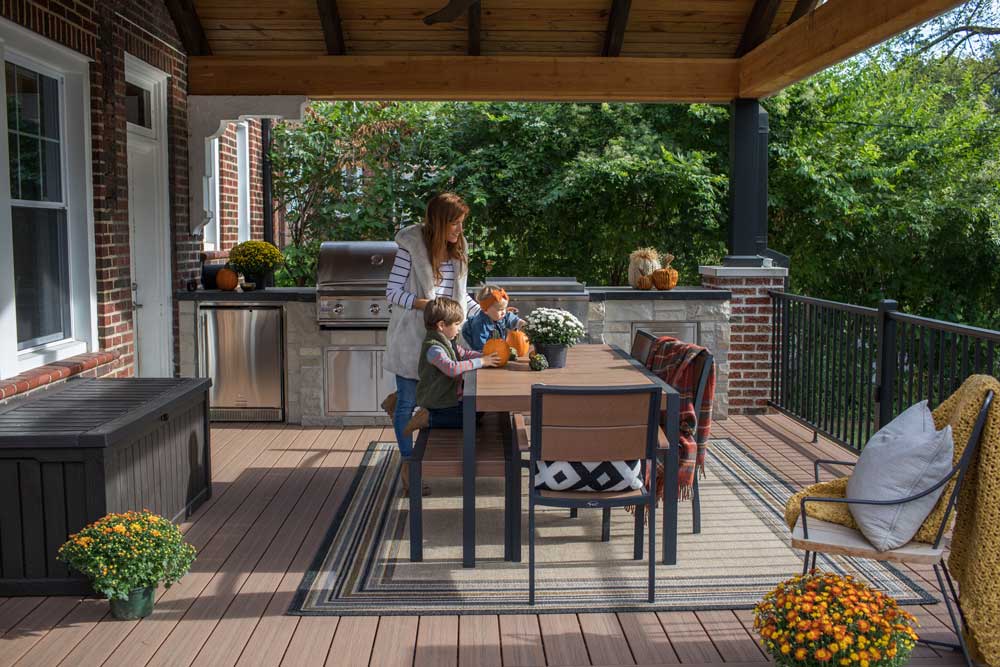
Gas grills are a popular choice for deck grilling, offering convenience and precise temperature control that many outdoor chefs appreciate. Their quick start-up times, even heat distribution, and minimal smoke production make them particularly well-suited for deck use. However, gas grills come with their own set of safety considerations that must be addressed to ensure safe operation on a wooden deck.
Advantages of Gas Grills for Deck Use
There are several advantages of choosing to use a gas grill on your deck. They provide quick start-up and precise temperature adjustment, allowing you to begin cooking almost immediately and maintain consistent heat throughout the grilling process. The even heat distribution characteristic of gas grills ensures that food cooks uniformly, reducing the risk of undercooking or burning. Additionally, gas grills produce minimal smoke compared to charcoal alternatives, making them a neighbor-friendly option for deck use in close-quartered living situations.
Potential Risks and Safety Considerations
Despite these benefits, gas grills pose potential risks that require attention. The primary concern is the possibility of gas leaks, which can lead to explosions or fires if not properly managed. Grease fires are another risk, as accumulated fats can ignite if not regularly cleaned.
Safety Features to Look For
When selecting a gas grill for deck use, prioritize models with built-in safety features. Look for grills equipped with automatic shut-off valves, which cut off gas flow if the flame goes out, preventing dangerous gas buildup. Flame tamers are another important feature, helping to distribute heat evenly and reduce flare-ups by vaporizing drippings. Effective grease management systems channel grease away from burners, minimizing the risk of grease fires.
The construction of the grill itself is also a safety consideration. Opt for models with sturdy construction that won’t easily tip, even in windy conditions. Wind-resistant burners are another valuable feature, maintaining consistent flames even when deck breezes pick up.
Proper Placement and Maintenance
Proper placement and maintenance of your gas grill is not to be avoided for deck safety. Ensure there’s adequate ventilation around the grill to prevent carbon monoxide buildup, a particular concern when grilling in partially enclosed deck spaces. Store propane tanks properly, and always in an upright position.
Regular maintenance is key to the safe operation of gas grills. Make a habit of cleaning grease traps and burners after each use to prevent buildup that could lead to fires. Before each grilling session, inspect gas lines and connections for signs of wear or damage. Consider installing a gas leak detector near your grill area for an added layer of safety.
Recommended Models for Deck Use
While specific model recommendations can change over time as new products enter the market, look for gas grills from reputable brands known for their safety features and build quality. Companies like Weber, Napoleon, and Blaze consistently produce grills with excellent safety records and durability suitable for deck use. Always check the latest safety ratings and user reviews before making a purchase to ensure you’re getting a grill that meets current safety standards.
By carefully selecting, properly placing, and diligently maintaining your gas grill, you can enjoy the convenience and performance of gas grilling while minimizing the risks associated with deck use. Remember, safe grilling practices not only protect your property but also ensure that your outdoor cooking experiences remain enjoyable for years to come.
Big Green Egg on Decks
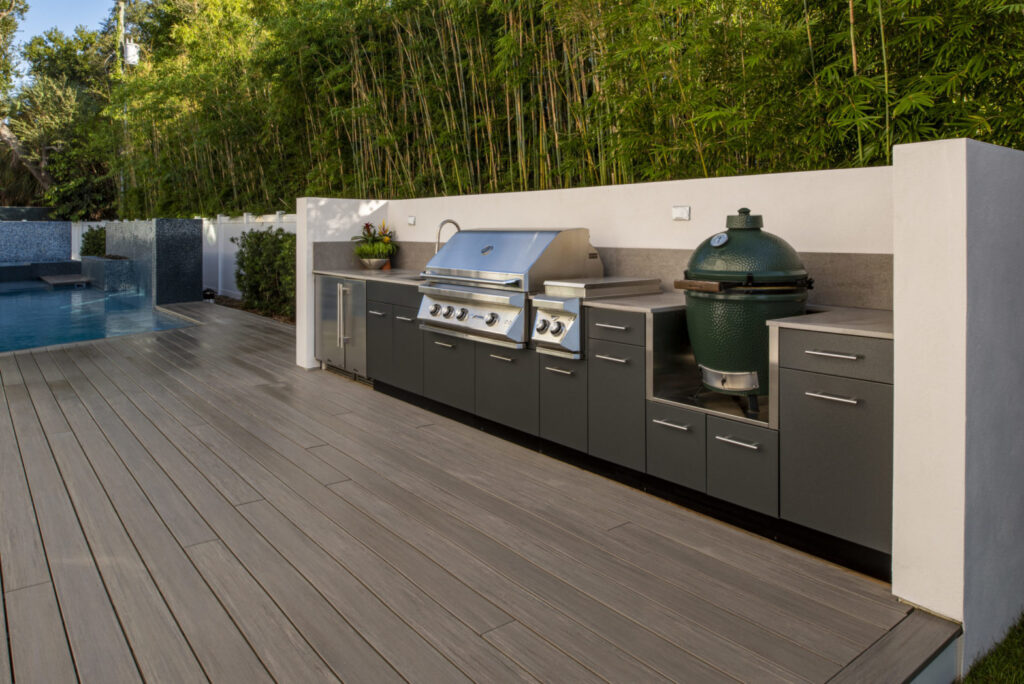
The Big Green Egg, with its distinctive shape and ceramic construction, has become an icon in the world of outdoor cooking. Its versatility and ability to maintain consistent temperatures make it a favorite among grilling enthusiasts. However, using a Big Green Egg on a deck requires specific safety considerations due to its unique design and high heat capacity.
Unique Features of Ceramic Grills
The Big Green Egg’s ceramic construction offers excellent heat retention and distribution, allowing for a wide range of cooking techniques from low-and-slow smoking to high-heat searing. This versatility comes with the advantage of fuel efficiency, as the ceramic walls help maintain cooking temperatures with less charcoal than traditional grills. However, the excellent heat retention also means that the exterior of the grill can remain hot for extended periods, posing a potential risk on wooden decks.
Safety Considerations for the Big Green Egg
When using a Big Green Egg on a deck, several safety factors need to be addressed:
Heat Transfer: The ceramic body of the Big Green Egg can transfer significant heat to the surface below. This heat transfer can potentially damage wooden decks or create a fire hazard if not properly managed.
Weight: Big Green Eggs are considerably heavier than most conventional grills. Ensure your deck can support the weight, especially if you’re using a large model.
Stability: The egg shape, while efficient for cooking, can be less stable than traditional flat-bottomed grills. Proper placement and use of stabilizing accessories are crucial for deck safety.
Ash and Ember Management: As a charcoal-based cooker, the Big Green Egg produces ash and can occasionally release embers, which need to be carefully managed to prevent deck fires. Clean out the ash when the grill is completely cooled or before your next grilling.
Best Practices for Deck Installation
To safely use a Big Green Egg on your deck, follow these best practices:
Use a heat-resistant base: Place your Big Green Egg on a fireproof mat or paving stones to protect the deck surface from heat transfer.
Consider a rolling nest: A wheeled stand designed for the Big Green Egg can make it easier to move the grill for cleaning and maintenance while providing additional stability.
Maintain clearance: Keep the Big Green Egg at least 10 feet away from any structures or flammable materials, just as you would with other grill types.
Use a spark screen: When cooking at high temperatures or in windy conditions, use a spark screen to prevent embers from escaping.
Proper ventilation: Ensure there’s adequate airflow around the grill to prevent heat buildup and allow smoke to dissipate.
Accessories to Enhance Safety
Several accessories can improve the safety of using a Big Green Egg on a deck:
EGG Mates: These folding side shelves provide a stable surface for food and tools, reducing the risk of accidents.
Plate Setter: This ceramic heat deflector allows for indirect cooking and helps manage heat distribution.
Ash Tool: Regular ash removal is crucial for fire prevention. An ash tool designed for the Big Green Egg makes this task easier and safer.
Temperature Controller: Devices can help maintain consistent temperatures, reducing the need to frequently open the lid and risk flare-ups.
By following these safety guidelines and utilizing appropriate accessories, you can enjoy the unique cooking experience of a Big Green Egg while maintaining deck safety.
Smokers on Decks
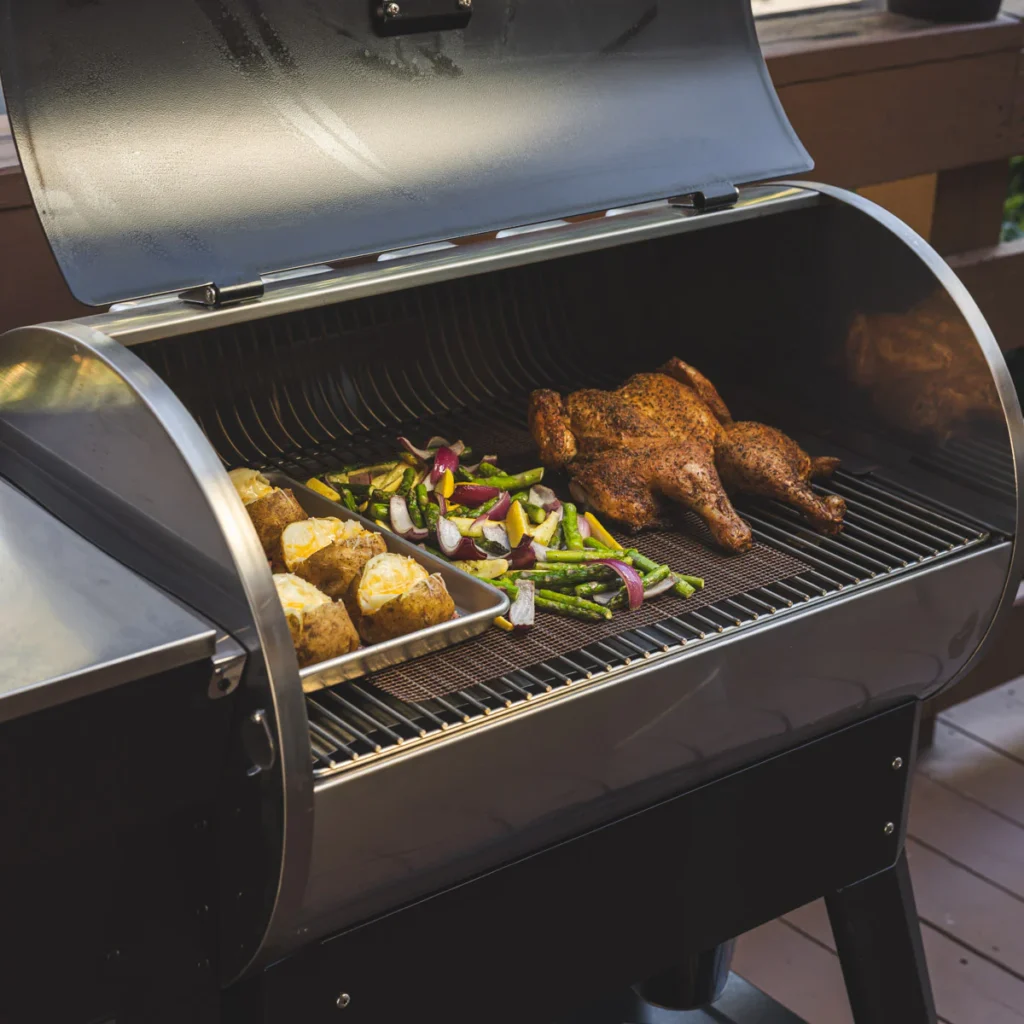
Smokers have gained popularity among outdoor cooking enthusiasts for their ability to impart rich, smoky flavors to meats and other foods. Using a smoker on a deck can create a fantastic outdoor cooking station, but it also presents unique safety challenges that need to be addressed.
Types of Smokers Suitable for Deck Use
Several types of smokers can be used on decks, each with its own safety considerations:
Electric Smokers: Generally the safest option for deck use due to precise temperature control and minimal fire risk.
Pellet Smokers: Offer good temperature control and are relatively safe, but require electricity and produce some ash.
Safety Measures for Different Smoker Designs
Regardless of the type of smoker you choose, certain safety measures should be implemented:
Heat-resistant base: Place your smoker on a fireproof mat or paving stones to protect the deck surface.
Proper clearance: Maintain at least 10 feet of distance between your smoker and any structures or flammable materials.
Stability: Ensure your smoker is on a level surface and cannot be easily tipped over.
Weather protection: Consider using a smoker cover when not in use to protect it from the elements and prevent rusting, which can lead to safety issues.
Proper Ventilation and Heat Management
Proper ventilation is crucial when using a smoker on a deck:
Airflow: Ensure there’s adequate airflow around the smoker to prevent heat buildup and allow smoke to dissipate.
Smoke direction: Be mindful of wind direction to avoid smoke blowing into your home or neighboring properties.
Temperature monitoring: Use reliable thermometers to monitor both the internal temperature of the smoker and the ambient temperature around it.
Recommended Deck-Safe Smoker Models
While specific model recommendations can change, look for smokers from reputable brands known for safety features and build quality. Some popular options include:
Masterbuilt Electric Digital Smoker: Known for its ease of use and safety features.
Traeger Pro Series 22 Pellet Grill: Offers precise temperature control and is relatively safe for deck use.
Always check the latest safety ratings and user reviews before making a purchase to ensure you’re getting a smoker that meets current safety standards and is suitable for deck use.
Blackstone Griddles on Decks
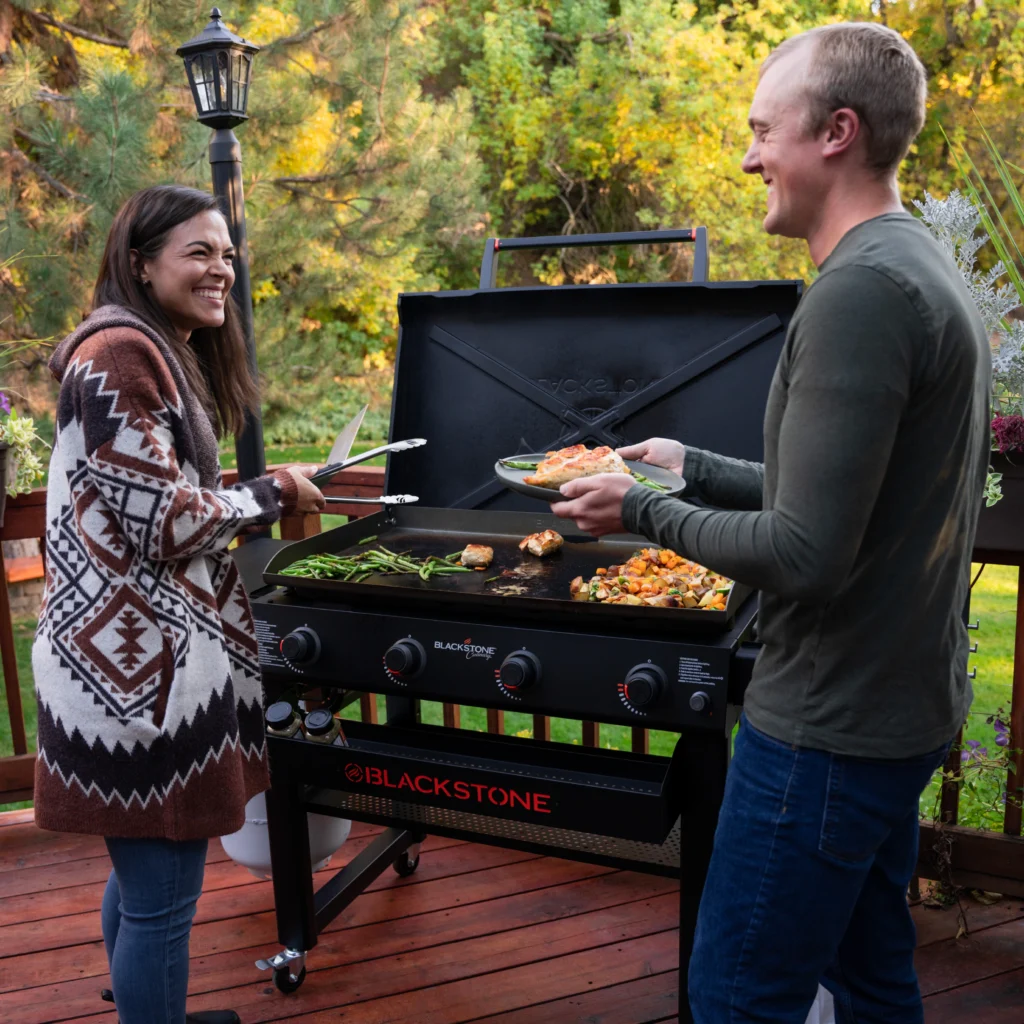
Blackstone griddles have surged in popularity, offering a unique flat-top cooking experience that’s perfect for everything from breakfast to dinner. Their design and cooking style present both advantages and specific safety considerations when used on a deck.
Benefits of Using a Blackstone on a Deck
Blackstone griddles offer several benefits for deck cooking:
Versatility: The flat cooking surface allows for preparing a wide variety of foods, from pancakes to stir-fries.
Even heat distribution: The solid steel cooktop provides consistent heat across the entire cooking surface.
Easy cleanup: The flat surface and grease management system make cleaning relatively simple, reducing the risk of grease buildup and potential fires.
Social cooking: The open design allows for interactive cooking experiences, perfect for entertaining on your deck.
Safety Features of Blackstone Griddles
Blackstone griddles come with several safety features that make them suitable for deck use:
Sturdy construction: Most models are built with a robust steel frame, providing stability on deck surfaces.
Grease management system: Integrated grease channels and a removable grease cup help prevent flare-ups and make cleanup easier.
Adjustable heat zones: Multiple burners allow for creating different heat zones, reducing the risk of overcooking or flare-ups.
Wind resistance: The flat top design is naturally more wind-resistant than open flame grills, reducing the risk of sudden flare-ups in breezy conditions.
Proper Setup and Maintenance for Deck Use
To ensure safe operation of a Blackstone griddle on your deck:
Level placement: Ensure the griddle is on a level surface to prevent grease from pooling and potentially causing fires.
Heat-resistant base: Use a grill mat or paving stones under the griddle to protect your deck from heat transfer.
Proper clearance: Maintain at least 10 feet of distance between the griddle and any structures or flammable materials.
Regular cleaning: Clean the cooktop and grease management system after each use to prevent grease buildup and potential fires.
Cover when not in use: Use a cover to protect the griddle from the elements, preventing rust and maintaining its safety features.
Best Blackstone Models for Outdoor Decks
While model recommendations can change over time, some popular Blackstone griddles well-suited for deck use include:
Blackstone 36″ Cooking Station: Offers ample cooking space and good heat control with four independent burners.
Blackstone 28″ Griddle Cooking Station: A more compact option that still provides plenty of cooking area for most families.
Blackstone Adventure Ready 22″ Griddle: A portable option that’s great for smaller decks or those who want the flexibility to cook in different locations.
As always, check user reviews before making a purchase to ensure you’re getting a griddle that meets current safety standards and is suitable for your specific deck setup.
Conclusion
By following these safety guidelines and choosing the right equipment, you can create a safe and enjoyable outdoor cooking space on your deck, whether you prefer the versatility of a gas grill, the flavor-enhancing capabilities of a Big Green Egg or smoker, or the unique cooking experience of a Blackstone griddle. Remember, regular maintenance and adherence to safety practices are key to ensuring your deck remains a safe and inviting space for all your outdoor cooking adventures.
Key takeaways when choosing your deck-safe grills include:
Proper placement: Regardless of the type of grill, maintaining adequate distance from structures and using heat-resistant barriers are essential for deck safety.
Regular maintenance: Keeping your grill clean and well-maintained not only enhances its performance but also significantly reduces fire risks.
Understanding your grill’s unique features: Each type of grill, from gas to ceramic to flat-top griddles, comes with its own set of safety considerations. Familiarizing yourself with these is key to safe operation.
Investing in safety accessories: From fire-resistant grill mats to wind guards and temperature controllers, the right accessories can greatly enhance your grilling safety.
Being prepared for emergencies: Always have a fire extinguisher nearby and know how to use it.
Considering your deck’s structure: Ensure your deck can support the weight of your chosen grill and consider any necessary modifications for enhanced safety.
Staying informed about local regulations: Be aware of any local laws or homeowners’ association rules regarding deck grilling.
Whether you’re searing steaks on a hot summer evening, smoking a brisket for a family gathering, or flipping pancakes on a sunny weekend morning, your deck can be the perfect stage for all your culinary adventures. So fire up that grill, gather your loved ones, and enjoy the pleasures of outdoor cooking – all while keeping safety at the forefront of your grilling experience.
Happy grilling, and here’s to many safe and delicious meals on your deck!




